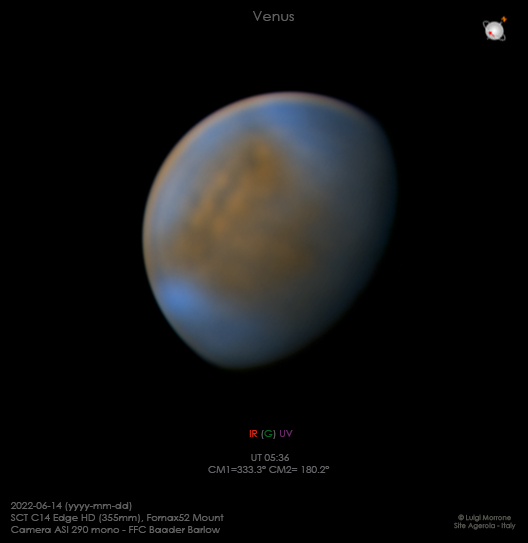The newest observations will help astronomers understand a planetary-scale wave in the atmosphere of our sister planet.

Luigi Morrone / S&T's Online Photo Gallery
A new study offers the potential for fresh insights into odd cloud behavior at Venus that astronomers still don’t fully understand.
The planet’s hot, acidic clouds are home to a discontinuity that sometimes resembles a bruise across the planet’s equatorial region. It’s actually a type of gravity wave, in which influences such as topography and convection create a sudden change in the atmosphere’s density.
While first noticed in 2016 in images from Japan’s Akatsuki orbiter, Javier Peralta (University of Sevilla, Spain) and colleagues realized that this cloud structure had been present at least as far back as the 1980s. Part of the reason it went unnoticed for so long is that it lurks deep in the Venusian atmosphere, where it is hidden from view by the thick upper cloud deck.
Now, in a new study forthcoming in Astronomy & Astrophysics, Peralta and colleagues report observations made last year, including the longest-ever uninterrupted recording of the discontinuity, from March 13th to July 31st. Prolonged observation periods such as this “give us more statistics to characterize the discontinuity and see it evolving,” explains Thomas Navarro (Space Science Institute), who wasn’t involved in the study. “The discontinuity exhibits a remarkable variability.” Long-term monitoring can capture those variations.
Peter Read (University of Oxford), who was also not involved in the study, concurs. “Virtually all planetary atmospheres have weather that is changing all the time,” he explains. “By collecting observations at frequent intervals over a long period of time, researchers can gain a lot of new information, for example, on how fast the feature moves, how it changes with time, and how long it lasts.”
The study lists 13 individual discontinuity events observed by amateurs, and 24 events total. Those observed by amateurs rotated faster than the planet itself, with an average rotation period (measured between April and July) of just over five days. The researchers also noted an unusual occurrence in June: the first appearance of the discontinuity at the cloud tops, though the feature normally dissipates before reaching that altitude. The wave possibly reached such heights owing to weak zonal winds.

J. Peralta et al. / Astronomy & Astrophysics 2023
Peralta and his colleagues drew on data from Akatsuki as well as ground-based images from NASA’s Infrared Telescope Facility on Mauna Kea in Hawai‘i, and from amateur observers in Estonia, Australia, and many places between.
To home in on the discontinuity, amateurs used high-pass and band-pass filters to suppress light from unwanted wavelengths. In post-processing, researchers then combined thousands of images, stacking them on top of one another to increase the signal.
Researchers were initially uncertain whether their data indeed captured the cloud discontinuity. Amateurs' efforts proved key in resolving the matter: The feature's location in Akatsuki's ultraviolet images, which tracked the upper clouds, matched its location in amateur images taken at the same time, using near-infrared images to reveal the middle-cloud layer.
“The quality and precision of the instrumentation available to amateur astronomers has improved markedly in recent years,” observes Read. “They are now able to make really important contributions to the study of planetary bodies in our solar system that seriously complement what the professionals can do.”
Navarro adds, “Amateurs can observe Venus when professional telescopes and space missions don’t. Thus, they bring crucial scientific value.”
JAXA / J. Peralta et al. / Astronomy & Astrophysics 2023
Uncertainty remains as to the nature of the discontinuity. It has previously been touted as the potential solution to a mystery that has long puzzled researchers of Venus: why the planet’s atmosphere rotates so much faster than its solid surface. The super-rotation is not fully accounted for by current circulation models and scientists have proposed that the discontinuity helps transport momentum from the lower atmosphere upward to the cloud tops.
Gerald Schubert (University of California, Los Angeles), another specialist in Venus’s atmosphere unaffiliated with the study, believes such discontinuities emerge when a large-scale atmospheric wave gets suddenly stronger. Similar mechanisms are at work on Earth.
This view jibes with that of Read, who paints a picture of an equatorially trapped wave, “a large-scale wave that occurs in the tropical regions of many planetary atmospheres, including Earth’s.” This wave is unique, though: “It has grown in amplitude so much that it has developed a sharp front on its leading edge, much like the way the crests of ocean waves on Earth develop a steep wall of water just before they break.”
Although Venus appears to be utterly unlike Earth, this cloud-smothered, slow-turning planet serves as a reference point for our understanding of our home world and others. As Navarro puts it, “If Venus did not exist, we could never have imagined such a planet, and would have missed a part of the range of diversity of planets outside our system.”
 0
0









Comments
You must be logged in to post a comment.